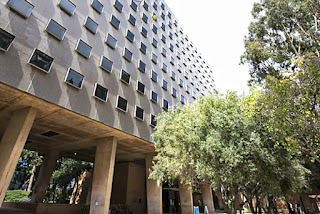From the 1st gallery showing of "Cosmological Events," I learned a great deal about our relationship and positionality within space and how we can represent our connection through art.
One of the main themes I took away from the artworks in the gallery was the sense of triviality and futility of life. In the grand scheme of the universe, we, as human beings, are but specs of space dust formed millions and millions of years ago. Galaxy Orchestra by Output and Our Celestial Bodies by Daniela Brill Estrada both remind the audience of their composition and origin from the cosmos in conjunction with our microscopic position within the vast emptiness.
 |
| Our Celestial Bodies by Daniella Estrada. Photo retrieved from https://cosmoselements.art/Artists. |
_compressed.jpg) |
| Galaxy Orchestra by Output. Screenshot taken by author on 21 April 2023. |
This intense use of imagination is seen in cosmological art and abstract art capturing dimensionality. Just as the author of "Flatlands: A Romance of Many Dimensions" wrote about our limitations when it comes to perceiving other dimensions (Abbot). Our perception of space is limited by the technology available to us - thus we can only attempt to recreate space and dimensionality through artworks and the imaginary - unlike the way we can recreate reality through rational perspective (Vesna 00:19:41 - 00:19:52).
For non-astrophotography artworks, like Morning Star by Anna Hoetjes and Biogram Blueprints by Eli Joteva, it is clear that we treat the universe as a mysterious, undiscovered expanse. These works showcase how we use our material world and experiences to illustrate the unknown, as Hoetjes' work draws striking similarities to the jellyfish in the deepest parts of the earth's ocean, and Joteva's work uses terrestrial plants and technology to illustrate the complexity of space and creation.
_compressed.jpg) |
| Morning Star by Anna Hoetjes. Screenshot taken by author on 21 April 2023. |
 |
| Biogram Blueprints by Eli Joteva. Retrieved from https://cosmoselements.art/Artists. |
Overall, the 1st presentation of Cosmological Events was very insightful on the relationship between cosmos and art and helped me develop a greater appreciation for the space I occupy in the universe.
_compressed.jpg) |
| Screenshot of registration/attendance, taken by author. |
Abbot, Edwin. "Flatland: A Romance of Many Dimensions." 1884.
Estrada, Daniella. Our Celestial Bodies. Cosmos Elements. https://cosmoselements.art/Artists.
Accessed 24 April 2021.
Hoetjes, Anna. Morning Star. Cosmological Elements #1 Online Gallery Showing. Retrieved on 21
April 2021.
Joteva, Eli. Biogram Blueprints. Cosmos Elements. https://cosmoselements.art/Artists. Accessed 24
April 2021.
Output. Galaxy Orchestra. Cosmological Elements #1 Online Gallery Showing. Retrieved on 21 April
2021.
Vesna, Victoria."Mathematics-pt1-ZeroPerspectiveGoldenMean.mov" YouTube, YouTube, 9 April
2012, https://www.youtube.com/watch
v=mMmq5B1LKDg&t=923s&ab_channel=UCOnlineMathematicspt1-
ZeroPerspectiveGoldenMean.mov















